When to plant garlic according to the lunar calendar in 2020, auspicious days
Using the lunar calendar, you can calculate all auspicious days for planting garlic in 2020. The influence of the satellite on most of the processes in nature has been proven by scientists and is beyond doubt. Vegetable crops respond differently to planting and grooming on different days of the moon cycle. For root crops and bulbs, all growth processes are accelerated during the waning moon. Garlic can be planted in autumn and spring, planting and growing technology will be slightly different.
When to plant winter garlic?
According to the calendar, several favorable periods for planting winter garlic in 2020 can be distinguished.
The moon is decreasing:
- in September: 1–8, 26–30;
- in October: 1–8; 25-31;
- in November: 1–6, 24–30.

On the days of the full and new moon, planting of any plants is not recommended:
- in September: 9 new moon, 25 full moon;
- in October: 9 new moon, 24 full moon;
- November: 7 new moon, 23 full moon.
The choice of the date in 2020 when it is best to plant winter garlic according to the lunar calendar will depend on the growing region. The bulbs should be able to take root in the soil but not germinate. This usually takes 2–3 weeks before the first frost.
When to plant spring garlic?
Spring planting of garlic according to the lunar calendar in 2020 is possible:
- in March: 3–16;
- in April: 1–15;
- in May: 1-14, 30-31 May.
Unfavorable days for planting:
- March 2 and 31 full moon, March 17 new moon;
- April 16 new moon, April 30 full moon;
- May 15 new moon, May 29 full moon.

The choice of a suitable date depends on the growing region. To root the bulbs, the soil temperature must be 5–6 ⁰С. In the central zone, this is usually the end of April and the beginning of May. Budding on a birch can be a good signal for planting. If by this time the water has left the site, and the earth has dried out enough, you can start planting.
Too warm (above 12-15 ° C) soil inhibits the development of the root system and the yield decreases. Therefore, it is better not to delay the planting of this culture.
Differences between spring garlic and winter garlic
There are several significant differences spring garlic from winter crops:
- Winter garlic is larger and consists of 4–10 large cloves around a thick shaft. A spring onion contains many slices of different sizes arranged in a spiral.
- Spring garlic (except for the "Gulliver" variety) does not form an arrow with air bulbs. Therefore, it is propagated only by teeth. Winter varieties are usually shot, and can be propagated by growing from bulbs.
- The spring crop lasts longer and remains viable for up to 2 years.
The soil
Garlic prefers loose, neutral soil with a high organic content.The root system of this culture is not very developed, it is enough to prepare beds with a depth of 30 cm. Humus, compost, peat and ash are added to the garden soil.
The landing site is changed annually with a possible return for 4–5 years. It is desirable that in the last season this area was occupied by green manure, legumes, young cabbage, cucumbers, zucchini.
Tall beds can be formed to avoid stagnant water. This is especially important for winter planting.

Small frosts will not harm the garlic if you take care of high-quality mulching of the beds. For these purposes, peat, straw or sawdust are used. The loose organic layer will help keep the soil moist and prevent crusting.
Winter plantings are additionally covered with branches for the winter in order to retain more snow.
Landing
The planting teeth are chosen the largest and without damage. For sowing spring garlic, only the outer cloves are usually selected.
The garlic is planted in rows every 30 cm, retreating between the cloves by 8–10 cm. The slices are placed in the holes vertically on the bottom with the sprout up. The layer of earth above the top of the clove should not exceed 2–3 cm in spring crops and 5–6 in winter crops. A layer of mulch 2-3 cm is laid on top.

Before planting, spring planting material can be germinated, for this it is soaked in a composition of potassium humate and ash (2 tablespoons per 1 liter). Then the cloves are wrapped in a damp cloth and placed in the refrigerator in the vegetable compartment for 5–6 days. Soaking and sprouting will help the wedges rehydrate and start quickly in the garden.
Winter garlic from bulbs
Growing winter garlic perhaps not only with teeth, but also with bulbs. In the first year after planting, small bulbs grow without separated cloves. Sevok is edible, but it is usually re-planted to obtain full-bodied bulbs. Such cultivation is beneficial for the renewal of seed material, as it eliminates the transmission of diseases from the soil. Sevka bulbs are larger because they have more nutrients to start growing.
On the garden bed, the bulbs are placed at a distance of 3-4 cm, keeping 8-10 cm between rows, the planting depth is 1-2 cm. Sevok is planted in the same way as the cloves.

Watering
High yields of this crop can be achieved only with regular watering. The lack of moisture inhibits the growth of the bulbs, up to the death of the roots. Yellow and dry tips of the leaves are a signal of dry soil. After the formation of 5–6 leaves, watering can be slightly reduced, since the bulb has already formed by this time. Garlic does not need watering 2-3 weeks before harvesting.
Top dressing
Garlic is fed 3-4 times per season. A week after germination, plants need nitrogen-containing fertilizers. For this, an infusion of mullein, bird droppings or complex mineral formulations is suitable.
After 2-3 weeks, feeding is repeated. After the formation of 5-6 leaves, phosphorus-potassium fertilizers are suitable.

Additional care
Winter plantings require timely removal of arrows (10 cm long), since the formation of air bulbs takes up a large amount of nutrients.
Spring crops often do not have enough time to ripen due to the short growing season. Therefore, you can tie the leaves into a knot in mid-August. This will cause the plants to stop growing the green part, and all the forces will be used to ripen the bulb.
Harvesting and storage of crops
Signal to harvesting winter garlic serves:
- cracking of inflorescences with bulbs;
- thin, strong and dried scales;
- the foliage of ripe garlic turns yellow and falls off;
- the teeth are easily separated from the stem.
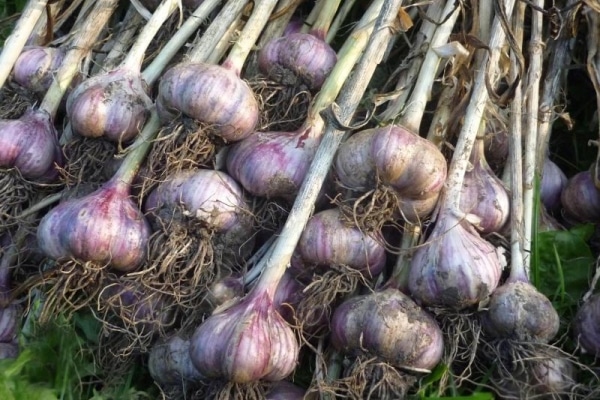
This occurs most often in mid-July.
Spring garlic ripens by late August or early September.
A crop that has not been harvested on time breaks down into separate cloves and is poorly stored. Some bulbs may re-germinate.
The day for cleaning is dry and sunny.The dug out garlic is left for 1–2 hours on the surface of the beds. Then it is scattered in a warm, dry place to dry. After two weeks, the foliage and roots are cut off, and all the bulbs are sorted out. Damaged and diseased bulbs are removed for quick use.
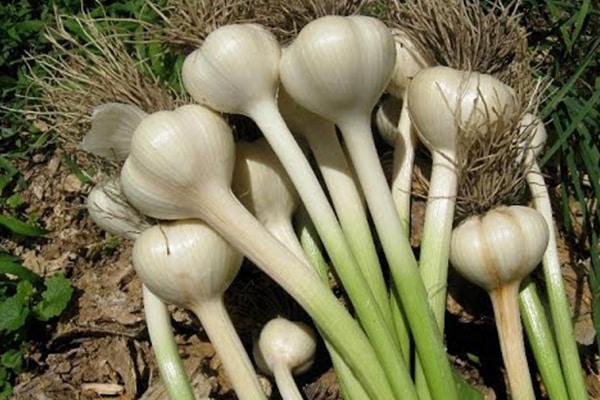
You can store your crops in slotted cardboard boxes, in linen bags, or simply hang bunches on the walls.
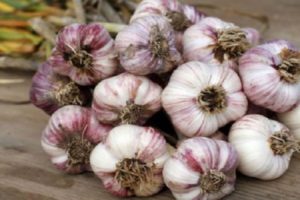
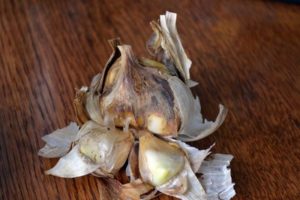
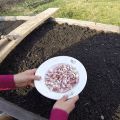
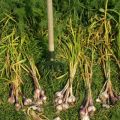
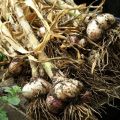
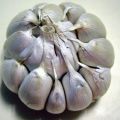

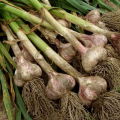
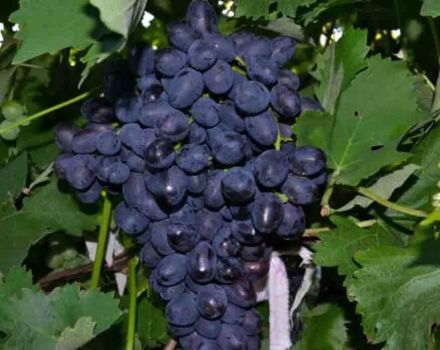

The article is useful and understandable. Thank! But the timing of planting winter garlic according to the lunar calendar is at odds with other articles ... And who to believe? (I will plant it according to yours, it just suits me better).